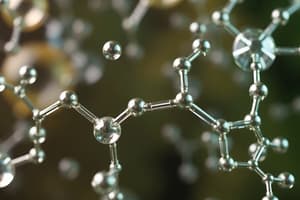Podcast
Questions and Answers
What is primarily studied in biochemistry?
What is primarily studied in biochemistry?
- The physics of chemical mixtures
- The structure of inorganic compounds
- The chemical processes within and related to living organisms (correct)
- The interactions between physical forces and matter
Which of the following best describes an amino acid?
Which of the following best describes an amino acid?
- An essential fatty acid
- A monomer used to build proteins (correct)
- A simple carbohydrate
- A nucleotide building block
What functional group is characteristic of amino acids?
What functional group is characteristic of amino acids?
- Carboxyl group (-COOH) (correct)
- Carbonyl group (C=O)
- Amino group (-NH2) (correct)
- Hydroxyl group (-OH)
In the context of amino acid chemistry, what role do side chains (R groups) play?
In the context of amino acid chemistry, what role do side chains (R groups) play?
Which statement is true regarding the structure of amino acids?
Which statement is true regarding the structure of amino acids?
Flashcards
Biochemistry Definition
Biochemistry Definition
Study of chemical processes in living organisms.
Amino Acids
Amino Acids
Organic molecules with amino and carboxyl groups.
Amino Group
Amino Group
Chemical group with nitrogen and hydrogen atoms.
Carboxyl Group
Carboxyl Group
Signup and view all the flashcards
R Group (Side Chain)
R Group (Side Chain)
Signup and view all the flashcards
Study Notes
Biochemistry 1: General Overview
- Biochemistry is the study of the chemistry of life, coined by Neuberg in 1903
- Includes the study of the chemical composition of living matter and the processes sustaining life
- Biochemistry overlaps biology, genetics, immunology, microbiology, physiology, and pharmacology
- Key issues include the structure of biomolecules, interaction between molecules, biosynthesis/degradation of molecules, energy conservation, and biological organization
Amino Acid Chemistry
- Amino acids are organic compounds with both an amino group (-NH₂) and a carboxyl group (-COOH)
- They are the building blocks of proteins, comprising about two-thirds of the cell's total dry weight
- 20 standard amino acids are the primary components of most proteins
- Amino acids differ in their side chains (R groups), determining their properties
- The alpha (α) carbon is asymmetric, bonded to a hydrogen atom, a carboxyl group, an amino group, and a variable R group
- Amino acids exist in zwitterionic forms at physiological pH
Classification of Amino Acids
- Based on polarity and chemical structure of their side chains (hydrophobic, polar, and charged groups)
- Based on catabolic end products (glucogenic, ketogenic)
- Based on biosynthetic precursors (e.g. X-ketoglutarate, oxaloacetate, pyruvate)
- Based on nutritional importance (essential vs. nonessential)
Studying That Suits You
Use AI to generate personalized quizzes and flashcards to suit your learning preferences.




